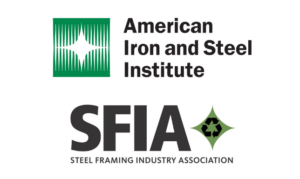Cold-formed steel (CFS) framing contractors may be surprised to learn that some standards referenced by the model building codes need clarification, says a report from the Association of the Wall & Ceiling Industry.
The article, “Codes & Standards: They’re Technical” appearing in the July 2022 issue of AWCI’s Construction Dimensions, says the 2018 International Building Code (adopted in at least 26 states) references two different AISI standards in different parts of the code.
“You have standards referenced in the code that could create different capacities for the same assembly,” says Patrick W. Ford, P.E., S.E., as quoted in the article. Ford is technical director of the Steel Framing Industry Association (SFIA) and a senior member of the engineering firm R.A. Smith, Inc., an SFIA member. He is also chairman of the American Iron and Steel Institute’s Framing Design Subcommittee for Cold-Formed Steel Framing.
The 2018 IBC references both the AISI S100-16 standard (issued in 2016) and the AISI S240-15 structural framing standard (issued in 2015). The later document references the older AISI S100-12 issued in 2012. But which part of the 2018 IBC has control? Both the 2016 AISI S100 and the 2012 AISI S100 are referenced.
“The question certainly affects the framing members the contractors deal with,” Ford says. “It’s not only the design strengths of the framing members, but also what constitutes a code-compliant protective coating on the studs.”
Defer Responsibility to the Designer of Record
Yes, the subtle differences in stud capacities between 2012 and 2016 AISI S100 standards, for example, could affect a contractor’s bid negatively.
- The newer S100-16, in some cases, reduces framing assembly capacities
- After the bid has been accepted, a contractor may need to purchase more or heavier CFS members to meet the S100-16 capacity requirements
- If project specifications reference a particular standard, but do so for the wrong code, a contractor “could end up being called out by the building inspector for his stud framing when he’s really done nothing wrong,” Ford says
AISI plans to update the AISI S100-16 Supplement 3 design standard for CFS framing in 2024, the AISI S220-20 the interior stud framing standard in 2026 and AISI S240-20 the structural framing standard also in 2026, according to the AWCI article.
For now, Ford says framing contractors should remain vigilant about the codes and standards that govern their projects.
“Write any contracts and do any bids in accordance with the standards listed in the project specs and no other. Then you defer the responsibility for that to where it belongs, which is with the designer of record,” Ford says. “It is their job to present contract documents that comply with the proper and current code.”
Who Takes the Lead in Metal Framing?
Many cold-formed steel (CFS) framing installation standards are written by ASTM International, whose most relevant consensus technical standard is the AC86 10-2021, “Cold-Formed Steel Framing Members—Interior Nonload-Bearing Wall Assemblies.”
However, the standards that govern the component metal products — the studs, joists and hat sections roll formed from sheet steel — are now mainly researched and written by the American Iron and Steel Institute.
Also, the Steel Framing Industry Association (SFIA) has a quality assurance and quality control program that certifies CFS products. By using SFIA-certified steel studs, a framing contractor is assured the components meet AISI requirements and only needs to abide by ASTM’s installation standards.
In addition, BuildSteel, which is powered by the SFIA, offers free project assistance for CFS framing for new and existing projects in the United States and Canada.
Click on the above link to learn more about BuildSteel’s free project assistance program.
Composite Slipped Head of Wall
Another area for framing contractors to be aware of involves the composite slipped head of wall testing assembly. Despite the slipped head of wall assembly being common, the codes and standards currently reference a non-slipped head of wall test assembly.
Ford is chairman of the AISI task group trying to get the standard changed. The goal of the task group is for both standard non-structural and EQ (equivalent) metal studs used in a composite wall test to be tested “per an applicable real-life situation,” Ford says.
While ICC refers to AC86 criteria for the composite slipped head of wall testing assembly — and ASTM and AISI also have test standards set — no standards currently address the slipped head of wall testing issue.
Ford says the AISI task group has finished its work of proposing a composite slipped head of wall standard that aligns with common field practices. The revised provisions are currently in the AISI ballot process.
BuildSteel will publish updates on the development of composite slipped head of wall testing assembly standards as news becomes available.
Additional Resources
- eBook: Specifying Cold-Formed Steel Framing: A Guide for Architects and Engineers
- AISI is Reaccredited by ANSI as an American National Standards Developer
- SFIA Releases Updated Cold-Formed Steel Guide Specs


